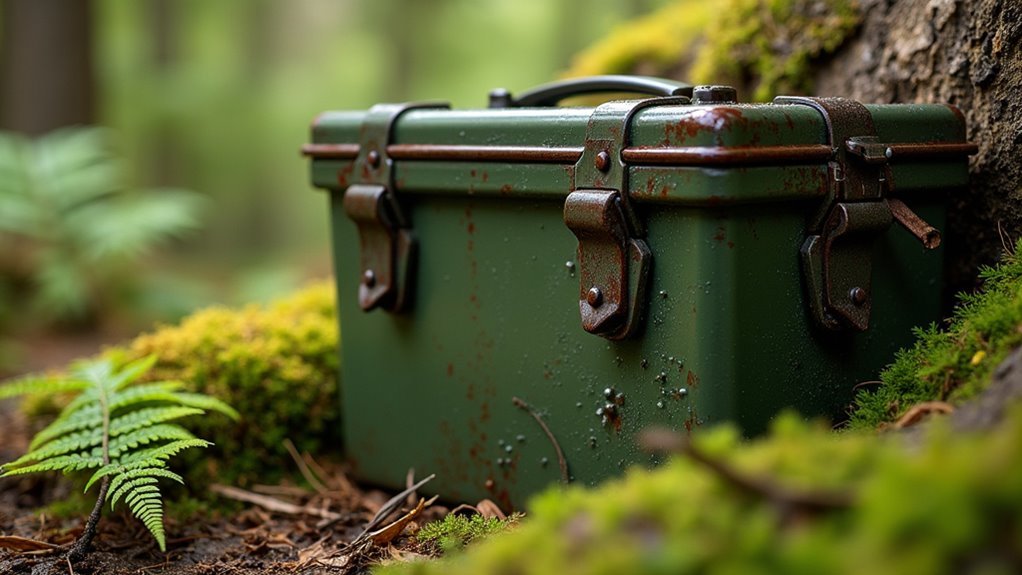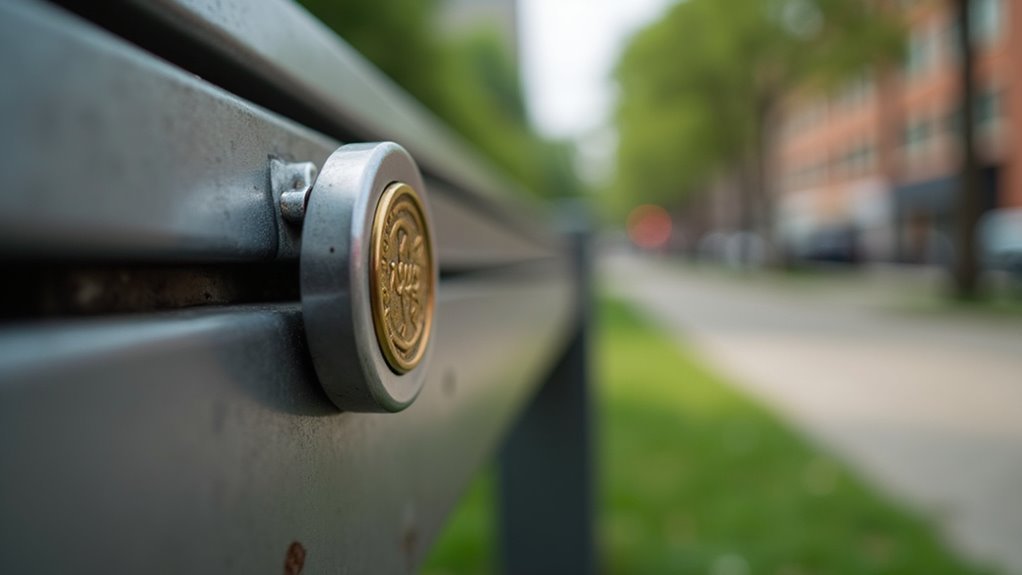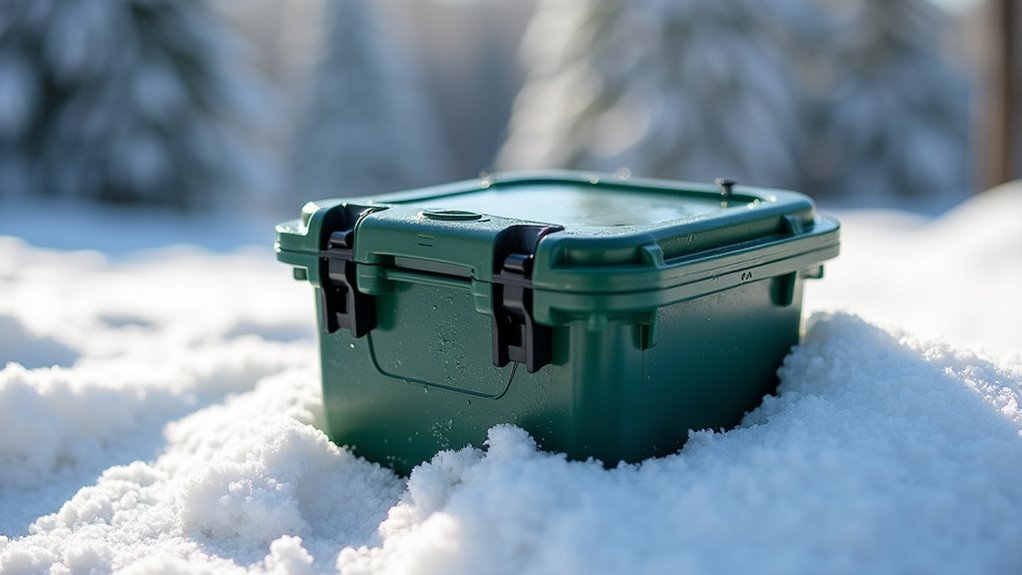Some of the links in this article may be affiliate links. If you make a purchase through these links, we may earn a small commission at no extra cost to you. Thank you.
Did you know that most failed geocaches have one thing in common? They’re simply using the wrong container for their environment. I’ve seen pristine Lock & Lock boxes disintegrate in desert heat and magnetic nanos wash away in the first rainstorm. After placing over 200 caches across varied terrains, I’ve learned that matching your container to your location isn’t just helpful—it’s essential for creating a hide that’ll still be there when seekers come looking.
Ammo Cans: The Gold Standard for Durability

Adventurers in the geocaching world know that nothing beats an ammo can when it comes to container reliability.
I’ve tested dozens of cache containers over the years, and honestly, these heavy-duty metal boxes are practically bombproof.
When you’re planning your next Hide, consider that ammo cans can literally survive being submerged underwater overnight—I’ve tried it myself!
What I love most is how their tight-sealing lids keep everything bone-dry, even in those super rainy locations where plastic containers would’ve failed months ago.
They’re weighty enough—probably a few pounds empty—to stay put during storms while still holding all your logbooks and trade items.
Plus, they blend into wooded areas surprisingly well.
I mean, if you want your cache to still be functional years later, an ammo can is your best bet.
Lock & Lock Containers: Watertight Protection for All Seasons
Why are Lock & Lock containers becoming the go-to choice for serious geocachers?
I’ve found that their airtight and watertight seals are practically unbeatable for hiding a cache in unpredictable weather.
Their airtight and watertight seals stand up to Mother Nature’s worst, making them perfect for cache protection in any environment.
Trust me, when you place a cache using these containers, you won’t worry about rain, snow, or humidity damaging your contents.
I love that they come in various sizes—from tiny micros to larger options that fit plenty of swag.
Many cachers, myself included, actually test these by submerging them overnight.
It’s kind of like giving them a final exam before deployment!
The plastic is super durable and resists UV damage, which, let’s face it, is essential when your container might sit in direct sunlight for years.
Their locking mechanism? Well, it’s reliable enough to outsmart curious animals too.
Micro Containers: Stealth Options for Urban Environments

Where do I hide caches in a concrete jungle packed with curious onlookers? Micro containers are my go-to solution when I want to hide a cache in urban areas. These tiny treasures, like match boxes, can be tucked into discreet spots that passersby (or muggles, as we call ’em) won’t notice.
| Container Type | Attachment Method | Best Urban Location |
|---|---|---|
| Match Box | Magnet | Street Signs |
| Film Canister | Velcro | Park Benches |
| Nano Tube | Rare Earth Magnet | Metal Railings |
I always test my micros by submerging them overnight—nobody wants soggy log sheets! Don’t forget to label your container with the GC code and contact info. In my experience, the strongest rare earth magnets work best, especially when you’re trying to stick something under that park bench without anyone raising an eyebrow.
Magnetic Hides: Perfect for Metal Surfaces in City Settings
When I’m geocaching in urban settings, I’ve found magnetic hides to be absolute game-changers for attaching containers to metal surfaces like signposts and bridge supports.
I typically use small tins with strong rare earth magnets, which stick reliably even after being exposed to rain and temperature changes—just make sure you’re placing them on clean, rust-free surfaces for maximum grip.
You’d be surprised how effectively these magnetic caches blend into city environments, making them nearly invisible to passersby while remaining accessible to fellow geocachers who know what to look for.
Magnetic Hide Fundamentals
Magnetic hides represent one of the most versatile container types I’ve encountered in my geocaching adventures.
If you’re looking for a place to hide something in an urban environment, these containers are your best friend.
They attach to any metal surface using strong neodymium magnets that can hold over 10 pounds—perfect for securing your cache even in windy conditions!
When you create a cache with a magnetic container, make sure it’s waterproof.
I’ve learned the hard way that rain can reduce adhesion by about 20% if not properly sealed.
Oh, and don’t forget to place them at least 528 feet from other geocaches—this is especially important in cities where space is tight.
The beauty of magnetic hides? Quick placement without damaging the environment.
Urban Stealth Techniques
Why do urban geocaches require special placement techniques?
I’ve found that city environments present unique challenges—constant pedestrian traffic and fewer natural hiding spots make stealth absolutely essential.
In my experience, magnetic hides are perfect for urban settings since they blend seamlessly with the metallic infrastructure that’s everywhere.
When I’m placing an urban magnetic cache, I look for a great location about 1-2 meters above ground on metal surfaces like lampposts or bridge railings.
I usually spend time waypoint averaging to guarantee accurate coordinates, since urban settings can interfere with GPS signals.
I think the best containers are weatherproof micro options—maybe an Altoid tin or key holder with a strong magnet that can withstand at least 10-20 pounds of pull force.
You don’t want your cache disappearing with the first strong breeze!
Weather-Resistant Magnet Options
The weather-resistance factor for magnetic geocache hides can’t be overstated if you’re planning an urban placement.
For your first hide in Geocaching, I’d strongly recommend neodymium magnets with rubber or epoxy coatings.
These babies can hold over 10 pounds while protecting against rain and rust!
I’ve found that lampposts and bridge railings make perfect homes for magnetic containers.
Just remember to maintain that 528-foot distance from other caches—it’s non-negotiable.
Want to test if your magnetic hide is truly weatherproof?
Well, here’s my trick: submerge it overnight in water.
If it stays dry inside, you’re golden!
In my experience, nano or micro containers with weatherproof seals work best for city settings where wind, snow, and curious humans are constant challenges.
Camouflaged Containers: Blending With Natural Surroundings
Natural disguise is perhaps the most essential skill you’ll need to master when placing geocaches in outdoor environments.
I’ve found that ammo cans or Lock & Locks painted in earth tones work beautifully, especially when the difficulty and terrain ratings suggest a challenging place to find.
When I’m setting up a hide, I’ll wrap containers in camouflage tape that matches the surrounding foliage—it’s amazing how effective this simple technique can be!
For micro caches, I attach them to tree bark or rocks using rare earth magnets, which keeps them hidden yet accessible.
Before finalizing any placement, I always test waterproofing by submerging containers overnight.
You know, the best camouflaged containers actually mimic natural objects—I once disguised a cache as a fallen log and it fooled even experienced cachers!
Weather-Resistant Options for Extreme Climates

When selecting containers for extreme weather conditions, you’ve got to account for the constant battle against nature’s harshest elements. In my experience, ammo cans are absolute workhorses – I’ve had ones last years in the field without a single “Needs Maintenance” log.
| Container Type | Climate Strength | Durability Rating |
|---|---|---|
| Ammo Cans | Cold/Wet | Excellent |
| Lock & Lock | Humid/Rainy | Very Good |
| Tupperware | General Weather | Good |
| UV-Stabilized | High Heat/Sun | Very Good |
| Metal Tins | Freezing | Good |
Make sure you test any container before deployment – I actually submerge mine overnight in water. If it stays dry inside, you’re golden! Nothing frustrates cachers more than soggy logbooks, and well, that’s just not the experience we want them to have.
Container Selection Based on Terrain Rating
How should you choose the perfect geocache container for your next hide?
Well, it all comes down to the terrain rating you’ve selected.
For my first geocache, I made the mistake of using a magnetic nano in a forest—big fail!
For terrain ratings 1-2 (urban areas), I’d recommend discreet micro containers with magnets that blend in.
They’re perfect when you’ve submitted your cache in high-traffic locations.
For moderate terrain (3-4) like parks or wooded areas, go with weather-resistant containers like Lock & Locks—they’ll stay dry when it rains, trust me.
For those challenging 5-rated terrains?
You’ll need something like an ammo can that can take a beating.
I always test mine by submerging them overnight—better safe than sorry!
Creative Custom Containers That Enhance the Experience
Creative containers truly elevate the geocaching experience from a simple “find the box” activity to an unforgettable adventure.
Creative containers transform geocaching from mundane box-hunting into thrilling adventures that captivate seekers’ imaginations.
When someone logs a find on one of my custom caches, I love reading their excited reactions!
I’ve found that personalization makes all the difference – from strong rare earth magnets that secure micro caches to metal surfaces, to containers painted to mimic their surroundings.
- Test durability – I always submerge new containers overnight before deployment to guarantee they’ll keep logbooks dry through any weather.
- Add identity – Include unique GC codes and contact info that transform standard hides into personal experiences.
- Use innovative materials – Repurposed items or 3D-printed designs can match specific themes and locations, bringing your cache vision to life.
Maintenance Considerations for Long-Term Cache Placement
Why would anyone place a geocache if they’re not prepared to maintain it?
Geocaching HQ’s Terms of Use actually require regular maintenance, and I’ve found that planning ahead saves enormous headaches down the road.
I always test containers by submerging them overnight—kind of like a trial by water, you know?
Ammo cans are my go-to for durability; they’re like the tanks of the container world, hardly ever needing replacement.
I check my online logs at least weekly for finder reports.
Sometimes they’ll mention issues I’d never spot on my own.
And don’t forget about secure attachments!
I’ve learned the hard way that strong rare earth magnets are essential for micro caches—otherwise, they’re, um, gone with the wind, so to speak.
Frequently Asked Questions
Do People Still Geocache in 2025?
Is geocaching dead? Absolutely not! I’ve seen its future popularity remain strong in 2025, with active forums, regular HQ updates, and tech evolution continuing to engage millions of enthusiastic participants worldwide.
What Not to Put in a Geocache?
I’ll never put forbidden items like money, illegal substances, or dangerous objects in my geocaches. I also avoid all perishable goods since they attract animals and create unpleasant messes.
Is Taking Geocaches Illegal?
By jove, yes! Taking geocaches without permission is illegal. I’d warn you that cache theft has real legal ramifications—it’s considered stealing someone’s property and violates geocaching’s fundamental principles of shared enjoyment.
What Do C and D Mean in Geocaching?
In geocaching, D means Difficulty rating (1-5 scale) of the cache find. C isn’t standard terminology, but likely refers to Container type. Both are part of Cache Ratings alongside Terrain Symbols.